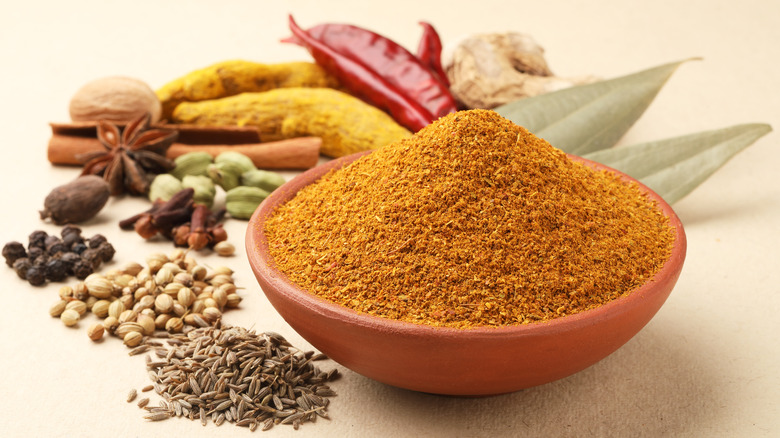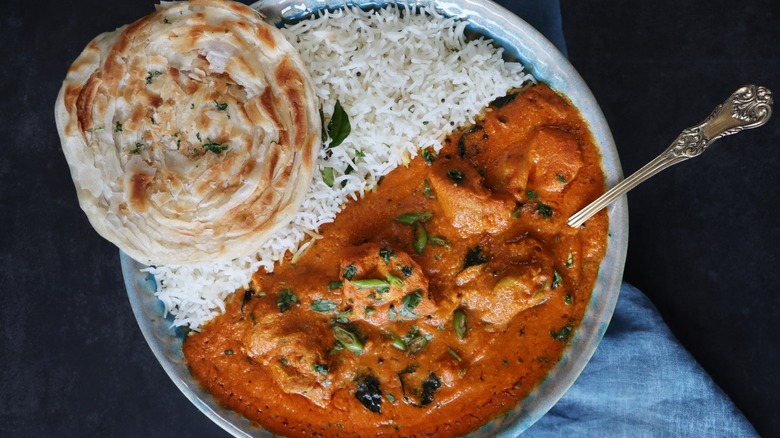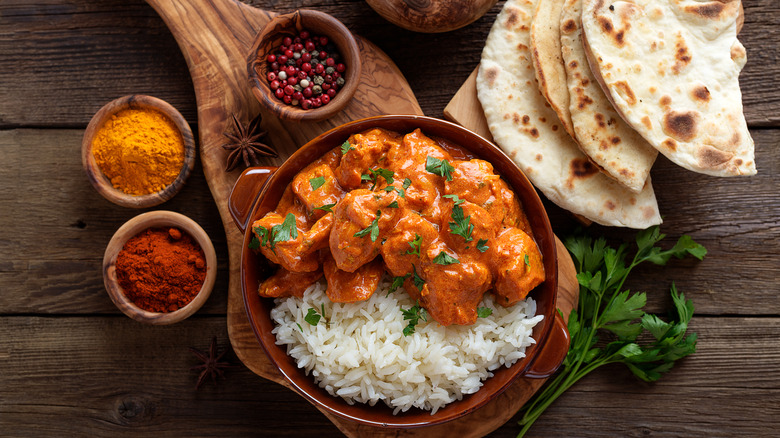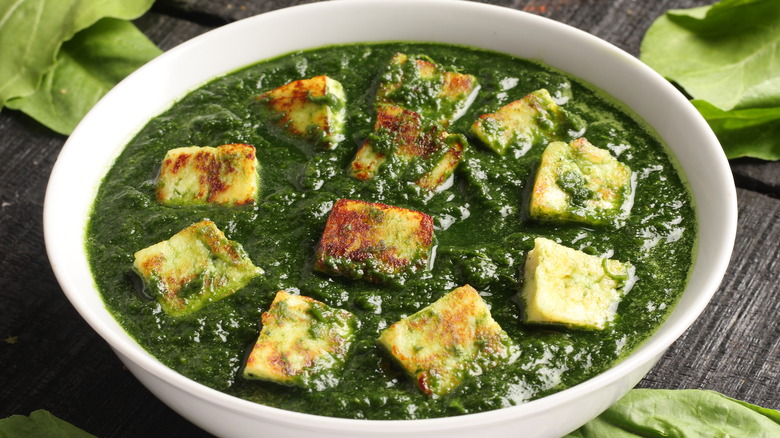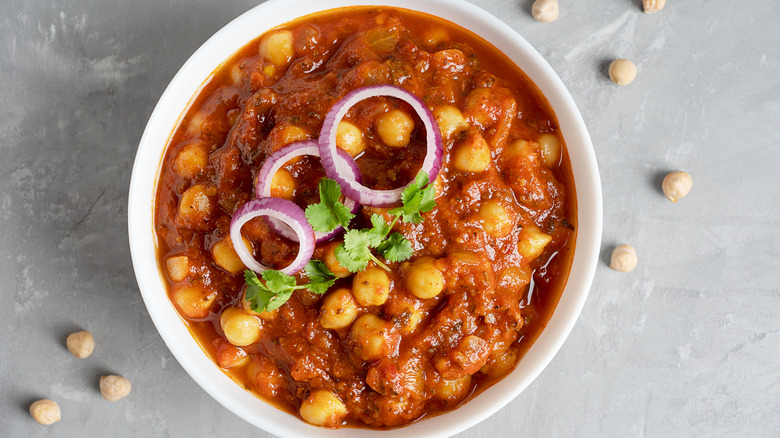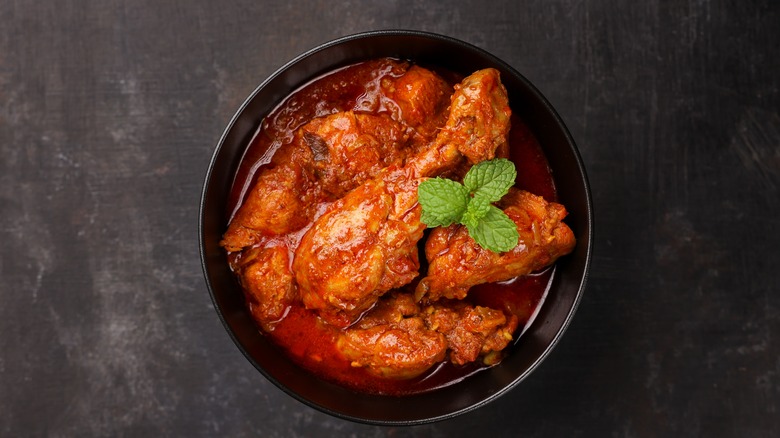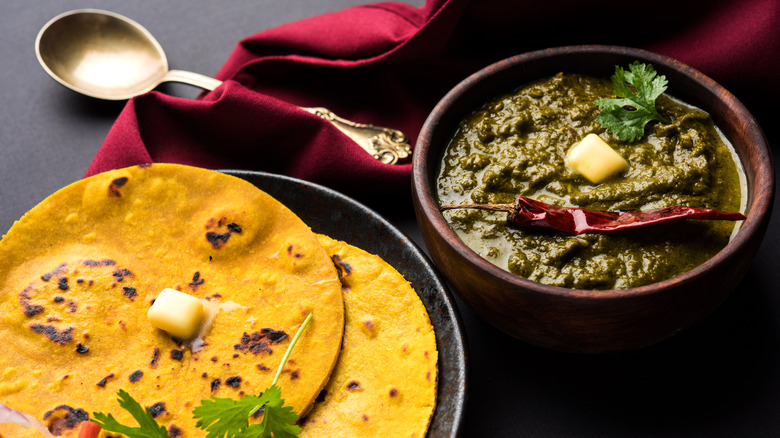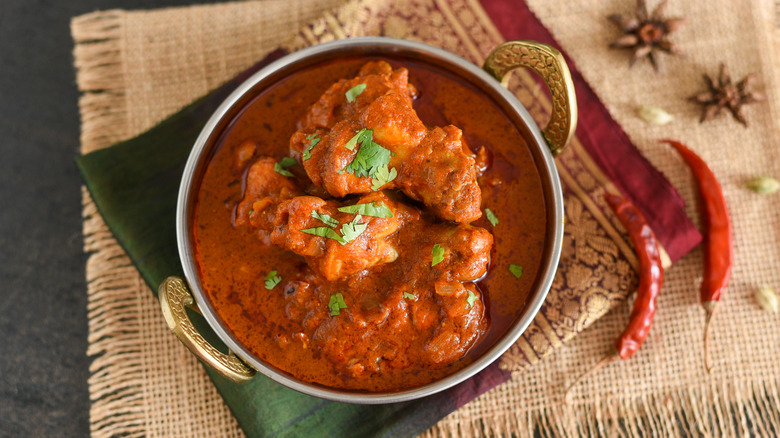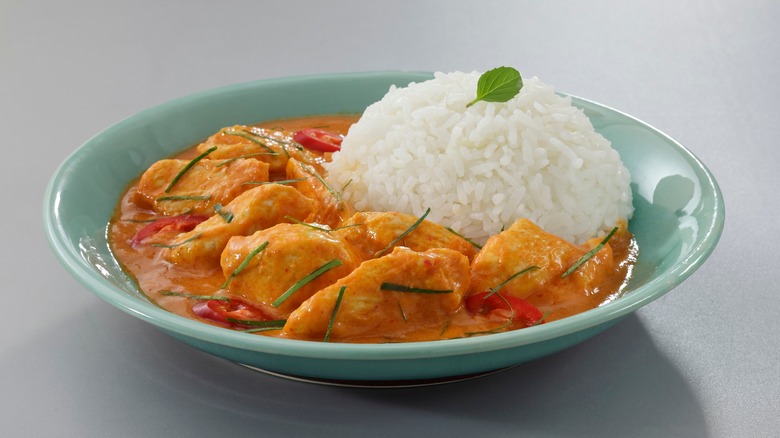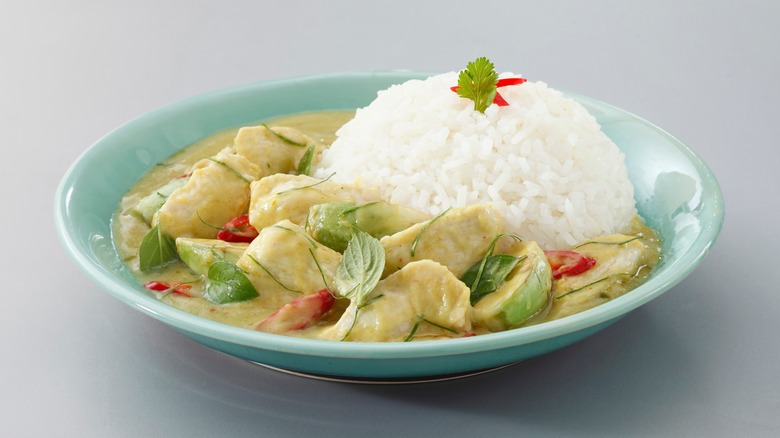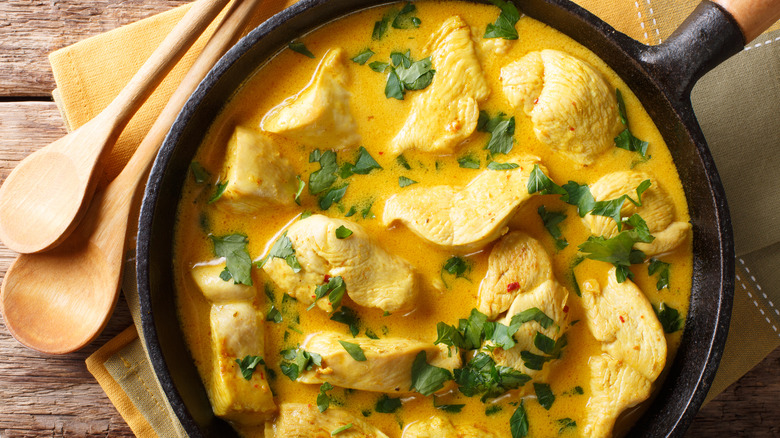10 Types Of Curry You Should Know About & The Best Ways To Cook With Them
Curry — an umbrella term that has evolved to encompass a wide variety of dishes — has been around for hundreds of years. Many trace its origin to the late 15th century, when Portuguese explorers traveled to India with vinegar and chili peppers. Over time, as more countries developed a taste for curry, the typical spices and flavors associated with it were concentrated and produced into curry powders. The prevalence of curry powders and increasing trade led to curry's spread around the globe.
The beauty of curry is that it's deeply flavorful and remarkably versatile. It can be made extra spicy with hot chili peppers or milder with tame greens like coriander and spinach. Meat-lovers can make it with ingredients like beef, pork, or chicken, pescatarians can make it with shellfish, salmon, or shrimp, and tofu curry is well-suited for vegetarians. Curry is perfectly at home with rice, noodles, or naan — or simply eaten in a bowl without any additional starches, which is a great option for keto-friendly, low-carb diets. The bottom line: Curry is delicious and malleable, making it a wonderful dish to cook for family and friends on a regular basis.
Learning the basics about some of the most popular kinds of curry is a great way to sharpen your cooking skills. Read on to discover more about these curries and some of the best ways to cook with them.
1. Butter chicken
The popularity of butter chicken can't be denied. Go to any Indian restaurant, and there's a very good chance that butter chicken will be not only on the menu but also the tables of fellow diners all around you. When chef Gordon Ramsey was asked on "Mythical Kitchen" what his last meal on Earth would be, butter chicken was one of the dishes that he selected for his hypothetical final feast. Butter chicken — creamy, rich, sweet, and spicy — is clearly a dish that's easy to fall in love with at first bite.
Butter chicken is typically cut into bite-sized cubes and marinated in a blend of ginger, garlic, chili powder, and salt and then seared in a pan until lightly browned. The par-cooked chicken is then set aside. Diced onions are added to the pan that the chicken was cooked in, along with some butter, and cooked until softened. Pureed tomatoes with a little water, garlic paste, salt, sugar, garam masala, and chili powder are then stirred into the pan and simmered. Cream, butter, and the cooked chicken are then added to the sauce, and everything is further simmered until the chicken is cooked through.
Pro tip: To go the extra mile, make your own garam masala powder from whole roasted spices. The flavor of store-bought garam masala pales in comparison to the vibrant flavors you'll extract from freshly blending whole spices at home — and your butter chicken will be light-years tastier.
2. Tikka masala
On the surface, it's probably pretty easy to confuse tikka masala with butter chicken. These curries tend to have a somewhat similar color, but there are still noticeable differences between them when it comes to taste and presentation.
Butter chicken tends to be a little bit milder and sweeter, while tikka masala generally has a tangier and spicier flavor profile that's often more tomato-based and darker red in color. Making tikka masala is very similar to preparing butter chicken, in terms of the ingredients and process. The main difference is that the sauce should contain less cream and more tomatoes, which is why the tikka masala tends to taste tangier. The chicken in tikka masala is often marinated in yogurt, which helps make it ultra tender and contributes to the overall tanginess. The curry sauce will often contain more chili peppers or dried chili flakes, which gives it a stronger hint of spiciness, though this will vary between restaurants and recipes.
3. Palak paneer
Those who prefer mild curries should enjoy palak paneer. "Palak" means "spinach," and paneer is a type of cheese. As its name suggests, this curry sauce is mostly made with spinach and features cubes of paneer cheese. Paneer cheese is non-aged, which gives it a very mild flavor. The texture of paneer can vary greatly depending on how long it's pressed — the longer it's pressed, the firmer it becomes. Paneer isn't a meltable cheese, and it tends to remain solid. It's often seared in a pan until it's lightly browned and crispy along the edges. It has a consistency comparable to firm tofu, but it's creamier and more flavorful because it's dairy-based.
Palak paneer can be made by lightly sautéing fresh spinach leaves with whole cashews. Once the spinach has been softened, it's blended with the cashews to form a bright green broth. When blended with the spinach, the cashews add a natural creaminess to the sauce. Onions, ginger, garlic, and a little touch of tomatoes are then sautéed and flavored with a pinch of garam masala. Once everything has been softened into a paste, the spinach puree is added to the sauce along with cubes of paneer. It's seasoned to taste with salt and thinned out with water if needed. Palak paneer should retain a green color, and there should be bite-sized chunks of paneer throughout the curry. It's best served with steamed rice, which can thoroughly soak up the spinach sauce.
4. Chana masala
Chana masala is a great curry for a vegetarian diet because the protein in this dish comes from chickpeas. If you're unacquainted with chana masala and looking for healthier plant-based protein alternatives, then this is the dish for you. Chickpeas are high in protein and also very nutritious, since they contain zinc, fiber, iron, copper, magnesium, and other minerals. Yet, despite this dish being quite healthy, it's still surprisingly savory and satisfying.
Diced onions are caramelized and then mixed with a flavorful paste of garlic, salt, ginger, chilis, and lemon juice. The onions and paste are then seasoned with cumin, turmeric, black pepper, coriander, and garam marsala. Once the spices have become fragrant and incorporated, crushed tomatoes are added into the mix. At this point, chickpeas are added to the curry and should be slowly simmered for at least 30 minutes. This will give the chickpeas time to soak up the flavor of the curry, becoming more tender in the process.
Chana masala is best when it's not too soupy but also not too thick. We're aiming for somewhere in between, where the liquid of the curry can cling to the back of a spoon without completely dripping off. Toward the very end of the cooking process, try stirring in some fresh cilantro, a squirt of lemon, fresh-cracked black pepper, and another dash of garam masala to liven up the flavors a little more.
5. Devil curry
Devil curry (or curry debal, which translates to "leftover curry") is known for its extra spicy flavor profile and its resourceful use of leftover ingredients. The custom of this dish is rooted in flexibility — which often means using leftovers from a special celebration or holiday to make a big batch of curry. A pile of leftover turkey from Thanksgiving or the extra roast from Christmas lingering in the fridge present perfect opportunities to manifest more deliciousness in the form of devil curry.
The bulk of devil curry is typically made with a mix of fresh red chilis and dried red chili peppers that are rehydrated in warm water. The usual suspects in most curries — onions, ginger, garlic, and turmeric — form the base of the sauce, along with chicken stock and mustard powder. The beauty of devil curry is that it openly invites just about anything from leftover potatoes to links of sausage. In essence, devil curry is almost like a jambalaya in that it often contains several different forms of protein within the same dish. Once the meat has been simmered and brought back to life in the curry's chili-heavy sauce, it's time to dig in and enjoy.
6. Saag
Saag curry often looks very similar to palak curry, since both of them are green in color. The main difference between these two curries is that palak is traditionally made with just spinach leaves, while saag curry is made with a wider variety of greens. Some of the greens in saag curry recipes tend to include mustard greens, fenugreek leaves, and cilantro.
Another difference between saag and palak is that saag is known for being a bit thicker and creamier. This is because heavy cream is added to the curry toward the end of cooking, which creates a richer and thicker texture. By contrast, palak often uses pureed cashews or just a little yogurt. Saag curry tends to prominently feature potatoes or chicken. If you have a lot of greens on hand in the kitchen, saag curry is a great way to put them all to use in a way that's flavorful.
7. Vindaloo
Vindaloo is known for being one of the spiciest variations of curry. The word "vindaloo" comes from Portuguese and is tied to two of the dish's original ingredients: vinho (wine vinegar) and alhos (garlic). Vindaloo eventually grew to include more spices and chili peppers, which gave it the kick of heat that it's known for today.
Vindaloo generally features meats such as lamb, beef, or chicken. The meat is often marinated for several hours in a flavorful paste made with ingredients such as vinegar, chili peppers, garlic, ginger, cloves, and cinnamon. The meat is then cooked in a hot pan and simmered with warm water to create a broth. The residual marinade on the meat blends with the broth to create a curry sauce that slowly thickens as it simmers. The taste of vinegar and garlic should gradually subside as the flavor of chili peppers becomes more assertive. If you enjoy spicier curries, vindaloo is a dish that's right up your alley.
8. Thai red curry
Thai red curry is a popular curry that's available at many restaurants. Thai red curry paste is also often available at many grocery stores. This makes it a great curry to try making at home, since premade curry paste is convenient and helps save time when it comes to preparation. Thai red curry's savory and spicy flavor makes it ideal for use with beef or shrimp, but it's also great with chicken.
Thai red curry gets its color from roasted red chili peppers and red bell peppers. The pepper paste is mixed with coconut milk and simmered for a few minutes. Next, vegetables are often added to the sauce, such as zucchini or more chili peppers. Fish sauce, chicken stock, chili flakes, and a touch of brown sugar are used to add some complexity. Toward the end of cooking, red curry is often brightened up with more fresh herbs, such as mint or cilantro, along with a drizzle of fresh lime juice for acidity. The final flavor should be creamy, tangy, and a little spicy with a hint of herbaceousness.
9. Thai green curry
Thai green curry tends to be milder than red curry. It has a refreshing vegetal flavor, thanks to the inclusion of green chili peppers and cilantro leaves. It also tends to have green onions. This is another popular curry that can be found on many Thai restaurant menus, and Thai green curry pastes are also widely available at many grocery stores.
Although the spice level is often adjusted depending on diner preferences, Thai green curry is typically only moderately spicy. Green curry paste is simmered with meat — often chicken — and then cooked with coconut milk. Tofu is also commonly featured in green curry. Sugar may be added to balance out the saltiness of the spices contained in the curry paste. Like other curries, green curry is often served with steamed white rice or naan. Sometimes green curry is mixed with noodles instead of rice. The dish is often garnished with more greenery, such as fresh cilantro leaves or sliced green chili peppers.
10. Thai yellow curry
Yellow curry is known for being the most mild of the holy trinity that includes red, green and yellow. While it's true that all curries are adapted to suit the particular tastes of each diner, yellow curry has a reputation for being on the sweeter side.
Instead of prominently featuring herbs like green curry or chili peppers like red curry, yellow curry's color and flavor largely derive from the use of dried spices and turmeric. You can use store-bought curry powder or try your hand at mixing some with a mortar and pestle. If you go the mortar and pestle route, crush and mix one ingredient at a time. Start with chili peppers and salt, and then add lemongrass, curry powder, turmeric, coriander, sugar, and fresh garlic. The curry paste should have a bright orange color to it. Once it's mixed with coconut milk during the cooking process, the curry will take on its signature yellow color.
